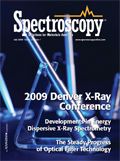DXC 2009: X-Ray Analysis Comes to the Rockies
Spectroscopy previews the 58th Annual Denver X-Ray Conference, to be held July 27–31 in Colorado Springs, Colorado.

Spectroscopy previews the 58th Annual Denver X-Ray Conference, to be held July 27–31 in Colorado Springs, Colorado.
The 58th Annual Denver X-Ray Conference on Applications of X-Ray Analysis (DXC), sponsored by the International Center for Diffraction Data (ICDD), will be held from July 27–31 at the Crowne Plaza Hotel in Colorado Springs, Colorado.

The Denver X-Ray Conference provides sessions on training, education, and applications and papers containing details about state-of-the-art techniques and future developments in X-ray analysis. Another important part of the meeting is the presence of leading manufacturers of X-ray equipment who exhibit their most recent equipment and have technical representatives available to answer questions about the products.
Workshops
Workshops will be held on Monday and Tuesday, July 27 and 28. Topics include "Advances in Detector Technology," "Quantitative Rietveld Analysis I and II," "Basic XRF," "Benefits and Limitations of Handheld XRF," "Phase Identification — Methods and Tools," and "Strategies for Advanced Materials Analysis with Lab & SR X-Ray Spectroscopy."

Plenary Session
This year's plenary session, "Getting the Lead Out — Again!" will be held on Wednesday morning, July 29. The invited papers being presented during this session are "Human Exposure to Lead and New Evidence of Adverse Health Effects: Implications for Analytical Measurements," "Getting the Lead Out — Again: Lead in FDA-Regulated Products," "The Truths and Myths of Toys' Testing for Lead — XRF to the Rescue," and "System Overload!!! — Restoring Order With XRF."
Awards
Several awards will be presented at DXC 2009. The 2009 Barrett Award will be presented to Robert Von Dreele of the Argonne National Laboratory, Argonne, Illinois. The 2009 Jenkins Award will be presented to Tim Fawcett of the International Center for Diffraction Data, Newtown Square, Pennsylvania. The recipient of the 2009 Jerome B. Cohen Student Award will be announced at the plenary session.
Poster Sessions
The Monday evening XRD poster session will be held in conjunction with a Wine and Cheese Reception sponsored by PANalytical, from 5:30 to 7:30 p.m. in the Summit Ballroom. Tuesday evening's XRF poster session will feature a Wine and Cheese Reception sponsored by Chemplex. This session also will be held in the Summit Ballroom from 5:30 to 7:30 p.m.
Exhibits
More than 30 companies will showcase their products in the Exhibit Hall, the Colorado Grand Ballroom, during the week.
Exhibit Hours:
Monday 10:00 a.m.–5:00 p.m.
Tuesday 10:00 a.m.–5:00 p.m.
Wednesday 12:00 noon–7:00 p.m.
Thursday 10:00 a.m.–2:00 p.m.
In addition, there will be a vendor-sponsored Wine and Cheese Reception in the Exhibit Hall from 5:00 to 7:00 p.m. on Wednesday, July 29. Spouses are welcome to attend all social functions.
Registration
For more information and to register online, visit the DXC website at www.dxcicdd.com. All on-site registrations will be conducted at the Conference Registration Desk, located on the ground floor (level one) of the Crowne Plaza Hotel, near the Colorado Grand Ballroom.
While in Colorado...
Pikes Peak, the most visited mountain in North America, and the second most visited mountain in the world after Mount Fuji in Japan, is just a short drive from the Crowne Plaza Hotel in Colorado Springs.
Towering 14,110 feet above sea level, Pikes Peak is a must-see site. More than 500,000 people venture to the top of Pikes Peak each year. There are three ways to get there: drive the 19-mile Pikes Peak Highway, which is open year round (weather permitting); hike the very steep, 13-mile Barr Trail, which starts at the base of Pikes Peak in Manitou Springs; or experience the nearly 9-mile-long Pikes Peak Cog Railway. This scenic option is open all year, weather permitting. The round trip takes just over 3 hours, and you are allowed 30 to 40 minutes on the summit to explore before the train leaves for the ride back down the mountain. Pikes Peak is home to one of Colorado's largest herds of Rocky Mountain Bighorn Sheep and a large variety of other flora and fauna.
For more information, visit: http://www.pikespeakcolorado.com/GeneralInformation.htm.

LIBS Illuminates the Hidden Health Risks of Indoor Welding and Soldering
April 23rd 2025A new dual-spectroscopy approach reveals real-time pollution threats in indoor workspaces. Chinese researchers have pioneered the use of laser-induced breakdown spectroscopy (LIBS) and aerosol mass spectrometry to uncover and monitor harmful heavy metal and dust emissions from soldering and welding in real-time. These complementary tools offer a fast, accurate means to evaluate air quality threats in industrial and indoor environments—where people spend most of their time.
NIR Spectroscopy Explored as Sustainable Approach to Detecting Bovine Mastitis
April 23rd 2025A new study published in Applied Food Research demonstrates that near-infrared spectroscopy (NIRS) can effectively detect subclinical bovine mastitis in milk, offering a fast, non-invasive method to guide targeted antibiotic treatment and support sustainable dairy practices.